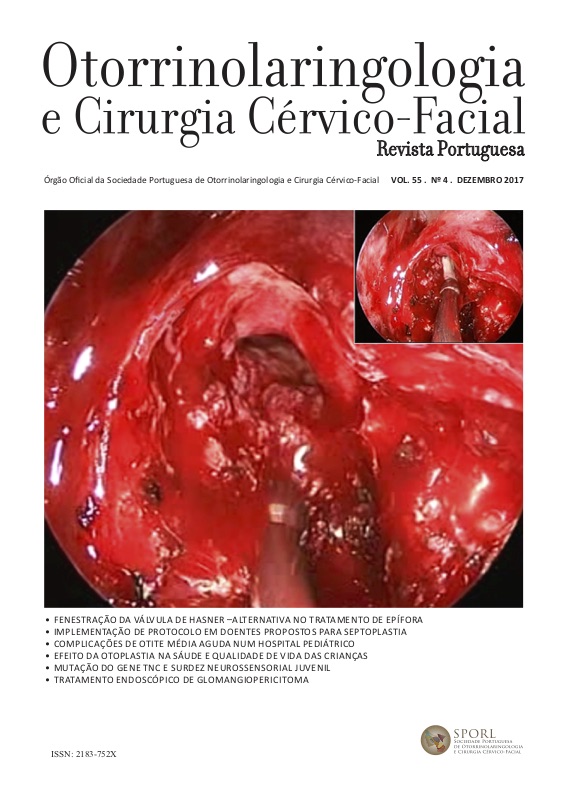Literature review and planning of protocol by means of sinonasal outcome test questionaire, rhinometry and computed tomography in patients programmed for septoplasty
DOI:
https://doi.org/10.34631/sporl.384Keywords:
rinometria acústica, septoplastia, tomografia computorizada, sinonasal outcome test - 22Abstract
Introduction: Septoplasty is proposed based on patient's complaints and medical evaluation. However, in modern evidence-based medicine, rhinometry, computed tomography (CT) and parameterized questionnaires are useful and, in the future, fundamental tools to document the work of an otorhinolaryngologist. The objective of this study is to review the literature on the evaluation of septoplasty results through objective methods, namely with sinonasal outcome test questionnaire (SNOT-22) and rhinometry and CT results, in order to protocol its use in our patients.
Methods: Study sample: patients proposed to septoplasty at Centro Hospitalar e Universitário de Coimbra (CHUC). Working tools: portuguese version of SNOT-22 questionnaire, acoustic rhinometry equipment and paranasal sinuses CT images.
Results: For all patients proposed for septoplasty at CHUC we developed the following protocol: filling of SNOT-22 questionnaire validated for portuguese language, being submitted to acoustic rhinometry in the week prior to the surgical intervention, at 3 and at 6 months post surgery. In addition, CT examinations of the paranasal sinuses will be reviewed if performed by the patient.
Conclusions: The use of guidelines is the first step to refine some procedures and validate them statistically. The implementation of this protocol will permit further studies to be worked on regarding the septoplasty and acoustic rhinometry, as well as evaluate patients’ satisfaction. In addition, it may predict the relevance of the proposal and surgical success of interventions.
Downloads
References
- Davis SS, Eccles R. Nasal congestion: mechanisms, measurement
and medications. Clin. Otolaryngol. 2004; 29:659–666.
- Neskey D, Eloy JA, Casiano RR. Nasal, septal, and turbinate anatomy
and embryology. Otolarygngol Clin N Amer. 2009; 42(2):193–205.
- Aziz T, Biron VL, Ansari K, Flores-Mir C. Measurement tools for the
diagnosis of nasal septal deviation: a systematic review. Journal of
Otolaryngology - Head & Neck Surgery. 2014;43:11.
- Szucs E, Clement PA. Acoustic rhinometry and rhinomanometry in
the evaluation of nasal patency of patients with nasal septal deviation.
Amer J Rhinology. 1998;12(5):345–352.
- Pirilä T, Tikanto J. Unilateral and bilateral effects of nasal septum
surgery demonstrated with acoustic rhinometry, rhinomanometry,
and subjective assessment. Am J Rhinol. 2001 Mar-Apr;15(2):127-33.
- Moore M, Eccles R. Objective evidence for the efficacy of surgical
management of the deviated septum as a treatment for chronic nasal
obstruction: a systematic review. Clin Otolaryngol. 2011 Feb; 26:106-
- Haavisto LE, Sipilä JI. Acoustic rhinometry, rhinomanometry and
visual analogue scale before and after septal surgery: a prospective
-year follow-up. Clin Otolaryngol. 2013;38:23-29.
- Toyserkani NM, Frisch T, Von Buchwald C. Postoperative
improvement in acoustic rhinometry measurements after septoplasty
correlates with long-term satisfaction. Rhinology. 2013 Jun;51(2):171-
- Dadgarnia MH, Baradaranfar MH, Mazidi M et al. Assessment
of septoplasty effectiveness using acoustic rhinometry and
rhinomanometry. Iran J Otorhinolaryngol. 2013 Spring;25(71):71-8.
- Kahraman E, Cil Y, Incesulu A. The effect of nasal obstruction
after different nasal surgeries using acoustic rhinometry and nasal
obstruction symptom evaluation scale. World J Plast Surg. 2016
Sep;5(3):236-43.
- Ardeshirpour F, McCarn KE, McKinney AM et al. Computed
tomography scan does not correlate with patient experience of nasal
obstruction. Laryngoscope. 2016 Apr;126(4):820-5.
- Karataş D, Yüksel F, Șentürk M et al. The contribution of
computed tomography to nasal septoplasty. J Craniofac Surg. 2013
Sep;24(5):1549-51.
- Günbey E, Günbey HP, Uygun S et al. Is preoperative paranasal
sinus computed tomography necessary for every patient undergoing
septoplasty? Int Forum Allergy Rhinol. 2015 Sep;5(9):839-45.
- Sedaghat AR, Kieff DA, Bergmark RW et al. Radiographic evaluation
of nasal septal deviation from computed tomography correlates
poorly with physical exam findings. Int Forum Allergy Rhinol. 2015
Mar;5(3):258-62.
- Mamikoglu B, Houser S, Akbar I,NG B et al. Acoustic rhinometry
and computed tomography scans for the diagnosis of nasal septal
deviation, with clinical correlation. Otolaryngology–Head and Neck
Surgery. 2000 Jul;123(1):61-68.
- Reitzen SD, Chung W, Shah AR. Nasal septal deviation in
the pediatric and adult populations. Ear Nose Throat J. 2011
Mar;90(3):112-5.
- Browne JP, Hopkins C, Slack R, Cano SJ. The Sino-Nasal
Outcome Test (SNOT): Can we make it more clinically meaningful?
Otolaryngology–Head and Neck Surgery. 2007;136:736-741.
- Buckland JR, Thomas S, Harries PG. Can the Sino-nasal Outcome
Test (SNOT-22) be used as a reliable outcome measure for successful
septal surgery? Clin Otolaryngol Allied Sci. 2003 Feb;28(1):43-7.
– Vilhena D, Duarte D, Lopes G. Sino-Nasal Outcome Test-22:
translation, cultural adaptation and validation in Portugal. Clinical
Otolaryngology. 2016;41:21-4.






